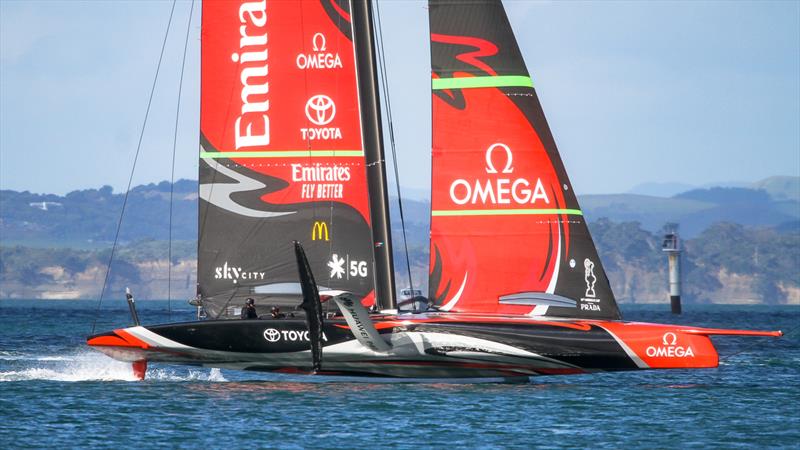
America's Cup Rialto: August 28 - A taste of Summer
by Richard Gladwell/Sail-World.com/NZ 28 Aug 2020 06:59 PDT
28 August 2020

Emirates Team New Zealand - Waitemata Harbour - August 28, 2020 - 36th America's Cup © Richard Gladwell / Sail-World.com
With temperatures peaking at 17°C, a 15kt westerly breeze, blue skies and bright sunshine, Cup fans gathered on Auckland's North Head to watch Emirates Team New Zealand train for three hours or so.
Only caught the last hour, but the Kiwis looked very smooth and rarely touched down while on a run.
The most interesting aspect of the day was a close look at how Te Aihe's bustle worked when flying low, and comparing that to American Magic's Defiant which has a Jekyll and Hyde aspect to low flight.
Today Sail-World's camera was set up low to the water, essentially just to get a new angle, but we could see under the boat and watch the bustle turning on an off.
After they tack, AC75's seem to have a soft spot as they make the transition onto the new foil, and in fact 10-15 secs after completing a tack (as defined in racing rules), the AC75 usually appears to lose height and often comes into brief contact with the surface of the water.
On Te Aihe the landing is very soft - almost barely perceptible, with no white water visible. Obviously from a side perspective we could only see the effect of the impact on the windward side - there may have been water pushed to leeward.
Te Aihe did a few of these dips before settling down at a steady flight height just a few inches clear of the water surface.
Defiant having a scow hull with a smooth under hull surface (no bustle), appears from study photos to have two distinct foiling modes.
In the marginal, or touch down conditions, her hull makes contact with the water, but unlike Te Aihe's bustle white water is kicked up, and across a bigger hull area than Te Aihe. This seems to push out to the leeward foil arm, giving the impression that the foil arm is creating a significant wash (and drag). The reality is that some/most of this wash is coming from the hull, not the foil.
When clear of the water (upwind and down) Defiant presents a completely different profile - riding on the rudder wing and leeward foil arm and wing, with what appears to be a very long bow section suspended clear of the water.
Defiant does have more keel rocker than Te Aihe, which means that her hull will contact the surface earlier than Te Aihe, but the immersed area of that contact should be less. But it is a rather pedantic discussion.
Where Defiant must make a gain is when her hull is clear of the water. Her smooth hull shape, must be more aerodynamically efficient than the chunkier shape of Te Aihe. To some extent we are looking at a 2013 America's Cup scenario where Oracle Team USA presented a much more aerodynamically efficient shape, offering less drag, which eventually was reflected in greater upwind speed - with OTUSA at times being 4-5kts faster than the Kiwi boat which was designed to be sailed at the original wind limit of 33kts, and had more hull volume.
Of the four first generation AC75's launched, Te Aihe has the most complex hull shape, while Defiant has the simplest and smoothest.
In between we have INEOS Team UK, which was in the same family as Defiant, but has moved away since her cosmetic surgery to add a rather crude bustle/skeg, but nevertheless adequate for the designers to be able to gauge what difference it made, if any.
Luna Rossa probably has the compromise solution - with a bustle that is kept a simple and aerodynamically clean as possible.
Having seen the scow and skiff shape in operation it seems that the gap between the two genres is closer than originally thought. However what is yet to be tested is how the scow handles a big sea state. There is plenty of video around showing that the skiff hull handles this quite easily, only the American Magic team know how Defiant handles this condition. The other factor that may come into play at the top end of the wind range is the skill of the helmsman/skipper to drive the boat hard.
American Magic skipper, Dean Barker turned in the best performance in this regard on the heaviest weather day of the 2017 America's Cup Regatta - Day 2 of the Semi-Finals, when Softbank Team Japan blitzed the conditions.
That's another point to be watched at another time.